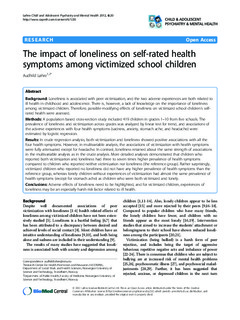The impact of loneliness on self-rated health symptoms among victimized school children
Journal article, Peer reviewed
Permanent lenke
http://hdl.handle.net/11250/2356227Utgivelsesdato
2012Metadata
Vis full innførselSamlinger
Originalversjon
Child and Adolescent Psychiatry and Mental Health 2012, 6(20) 10.1186/1753-2000-6-20Sammendrag
Background: Loneliness is associated with peer victimization, and the two adverse experiences are both related to
ill health in childhood and adolescence. There is, however, a lack of knowledge on the importance of loneliness
among victimized children. Therefore, possible modifying effects of loneliness on victimized school children’s selfrated
health were assessed.
Methods: A population based cross-section study included 419 children in grades 1–10 from five schools. The
prevalence of loneliness and victimization across grades was analyzed by linear test for trend, and associations of
the adverse experiences with four health symptoms (sadness, anxiety, stomach ache, and headache) were
estimated by logistic regression.
Results: In crude regression analysis, both victimization and loneliness showed positive associations with all the
four health symptoms. However, in multivariable analysis, the associations of victimization with health symptoms
were fully attenuated except for headache. In contrast, loneliness retained about the same strength of associations
in the multivariable analysis as in the crude analysis. More detailed analyses demonstrated that children who
reported both victimization and loneliness had three to seven times higher prevalence of health symptoms
compared to children who reported neither victimization nor loneliness (the reference group). Rather surprisingly,
victimized children who reported no loneliness did not have any higher prevalence of health symptoms than the
reference group, whereas lonely children without experiences of victimization had almost the same prevalence of
health symptoms (except for stomach ache) as children who were both victimized and lonely.
Conclusions: Adverse effects of loneliness need to be highlighted, and for victimized children, experiences of
loneliness may be an especially harsh risk factor related to ill health.
